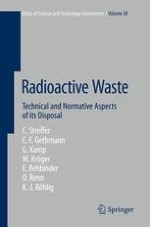Radioactive waste (above all highly radioactive wastes from nuclear installations) caused by research, medicine and technology must be disposed of safely. However both the strategies disputed for the disposal of radioactive waste as well as concrete proposals for choosing a location for final waste disposal are highly debatable.
An appropriate disposal must conform to both complex, technical requirements and fulfill the radio-biological conditions to appropriately protect man and nature. Ethical, legal and social conditions must also be considered. An interdisciplinary team from various, relevant fields compiled the current status-quo and developed criteria and strategies, which on the one hand meet the requirements of optimal warning and prevention of risk for present and future generations, and additionally on the other hand meet the needs of what current society agrees what is expected to be allowed.
This study can be understood as an advanced and continuing contribution to the corresponding scientific specialized debates, due to its interdisciplinary treatment. At the same time it serves as a fundamentally informing contribution to public and political debates, offering an easily comprehensible executive summary and precise content recommendations.
